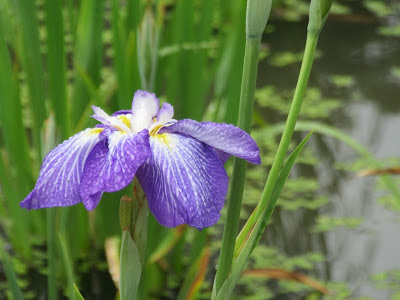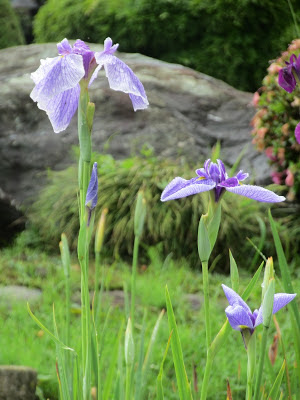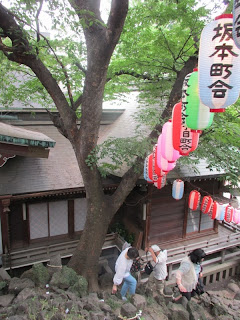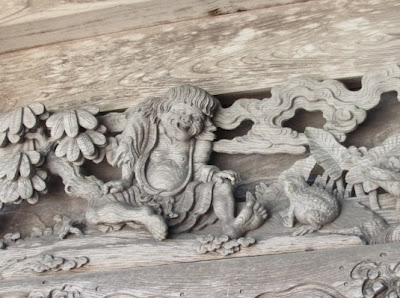神田川にかかる昌平橋から北西の方向を見た図です。
といっても昌平橋は右下にちょこっと見えているだけですが。
Hiroshige is standing on the Shohei-bashi Bridge over Kanda River, looking northwest.
A bit of the bridge is showing in the lower right.
神田川は自然の川ではなく、1610年代に神田山を掘って隅田川まで伸ばした人工の川です。隅田川から荷物を積んだ舟がこの川を上ることができるようになったので、各地に荷物を陸揚げする河岸(かし)が設けられました。橋の向こうに材木市場が見えますね。雨の中、蓑(みの)をかぶって舟をこぐ人が見えます。木材を運んでいるんでしょうか?
The Kanda River is not a natural river. It is a channel carved through Kanda Mountain into Sumida River in the 1610s. Cargo boats from Sumida River could come up this channel, so there were several markets along the Kanda River. Can you see the one, lumber markets on the other side of the river?
Boatmen wearing straw rain capes are pulling their boats in the rain.
対岸に見えるのは昌平坂。外塀が見えているのが湯島聖堂です。
The slope we see here is Shohei-zaka slope.
Along the slope is Yushima Seido Temple, of which only the outer wall is shown.
湯島聖堂は今もありますね。行ってみましょう。
The temple is still on the same spot. I went to see it.
いいですね!昌平坂も外塀も広重のころとあまり変わっていないように見えます。(^^)
How nice!
The slope and the wall remain almost the same. (^^)
昌平坂と湯島聖堂 Shohei-zaka slope and Yushima Seido Temple
さてこれが仰高門(ぎょうこうもん)です。
This is Gyoko-mon gate.
湯島聖堂はお寺でも神社でもなく儒学の祖、孔子を祀っています。
Yushima Seido Temple is not a Buddhist temple.
It's a temple that enshrines Confucius, a Chinese philosopher who started Confucianism in China some 2500 years ago.
![]()
孔子 Confucius
徳川幕府は孔子を祖とする朱子学を正学とし、1690年、5代将軍綱吉がこの湯島聖堂を創建しました。
後には幕府直轄の学校昌平坂学問所も併設されました。
Under Tokugawa Shogunate, neo-Confucianism became the orthodox creed of the state. And in 1690, this temple was built by the 5th Shogun Tokugawa Tsunayoshi.
Yushima Seido Temple is not a Buddhist temple.
It's a temple that enshrines Confucius, a Chinese philosopher who started Confucianism in China some 2500 years ago.
.jpg)
孔子 Confucius
徳川幕府は孔子を祖とする朱子学を正学とし、1690年、5代将軍綱吉がこの湯島聖堂を創建しました。
後には幕府直轄の学校昌平坂学問所も併設されました。
Under Tokugawa Shogunate, neo-Confucianism became the orthodox creed of the state. And in 1690, this temple was built by the 5th Shogun Tokugawa Tsunayoshi.
Later, the state-run school called Shoheizaka Gakumonsho was also established on its premises.
関東大震災の火災を免れた唯一の木造建造物入徳門です。
Nyutoku-mon Gate, the only wooden survivor of the Great Kanto Earthquake on the premises
関東大震災の火災を免れた唯一の木造建造物入徳門です。
Nyutoku-mon Gate, the only wooden survivor of the Great Kanto Earthquake on the premises
孔子とその弟子4人の像を祀った大成殿。大きかったです。
The main hall, Taisei-den. It is very big.
土日祝日には内部も公開されています。
It is open on weekends and holidays.
There are statues of Confucius and four wise men, and Chinese offerings inside.
大成殿の屋根には見慣れないものが乗っています。
On the roof are these unfamiliar objects.
It is open on weekends and holidays.
There are statues of Confucius and four wise men, and Chinese offerings inside.
大成殿の屋根には見慣れないものが乗っています。
On the roof are these unfamiliar objects.
一番上のしゃちほこのようなものは鬼犾頭(きざんとう)といいます。しゃちほこは頭が虎で体が魚なのに対し、鬼犾頭(きざんとう)は頭が龍で体が魚。頭から水を噴き出しています。しゃちほこ同様火除けの意味があるようです。
This one looks similar to Shachihoko (an imaginary animal we often see on top of Japanese castles and temples. It has the head of a tiger and the body of a fish. )
But this has the head of a dragon and the body of a fish, and is blowing water from its head. This is called Kizanto. Like Shachihoko, it protects the building from fire.
こちらは鬼龍子(きりゅうし)といって、おなかに蛇の鱗がある想像上の動物です。やはり建物を守っているようです。
怖いような、かっこいいような。
![]()
This one looks similar to Shachihoko (an imaginary animal we often see on top of Japanese castles and temples. It has the head of a tiger and the body of a fish. )
But this has the head of a dragon and the body of a fish, and is blowing water from its head. This is called Kizanto. Like Shachihoko, it protects the building from fire.
こちらは鬼龍子(きりゅうし)といって、おなかに蛇の鱗がある想像上の動物です。やはり建物を守っているようです。
怖いような、かっこいいような。
This is Kiryushi.
It is also an imaginary animal that has a snake-like scales on its stomach. It is guarding the temple from the evil.
ちょっと中国的な感じがする湯島聖堂でした。
Yushima Seido Temple was quite interesting.
Yushima Seido Temple was quite interesting.
さて昌平橋に向かいましょう。
Now, let's go to Shohei-bashi Bridge.
![]()
昌平橋の上にはJR総武線が走っています。
JR Sobu Line runs overhead.
![]()
昌平橋と総武線 Shohei-bashi Bridge and JR Sobu Line above
Now, let's go to Shohei-bashi Bridge.
.jpg)
昌平橋の上にはJR総武線が走っています。
JR Sobu Line runs overhead.
.jpg)
昌平橋と総武線 Shohei-bashi Bridge and JR Sobu Line above
昔は緑に覆われた堤も今ではコンクリートで固められてます。
Once the green bank, now all concrete.
Once the green bank, now all concrete.
さて、広重の視点に立って眺めてみると…。
Let's see how it looks from Hiroshige's viewpoint.
I stood at the bridge and looked northwest.
ちょうど電車と水上バスが同時にやってきたので、急いでシャッターを切りました。
川沿いには小さなお店さんが並んでいて、その先にある湯島聖堂は全然見えません。
広重のころののどかな感じは微塵もありませんね。
でも神田川を通る船も入ったし、満足です。
Then, a train came rumbling. And a water bus came, too.
I hurriedly took this photo.
The small stores along the river made it impossible to see the Yushima Seido Temple.
It doesn't look as peaceful as Hiroshige's times.
But I was happy I got a boat in my photo.
隅田川クルーズほど知られていませんが、最近は日本橋を出発して神田川を行くクルーズもあるようです。
眺めがいいとは思えませんが、でも江戸の人たちと同じように神田川を船で行くのは面白そう。
いつか行ってみようと思います。
Though not as popular as Sumida River water-bus cruise, I've heard they now have Kanda River cruise, departing from Nihonbashi-bridge.
It wouldn't be the most scenic cruise.
But I would like to see Tokyo from the river, just like Edo people used to do.
Well, someday.
川沿いには小さなお店さんが並んでいて、その先にある湯島聖堂は全然見えません。
広重のころののどかな感じは微塵もありませんね。
でも神田川を通る船も入ったし、満足です。
Then, a train came rumbling. And a water bus came, too.
I hurriedly took this photo.
The small stores along the river made it impossible to see the Yushima Seido Temple.
It doesn't look as peaceful as Hiroshige's times.
But I was happy I got a boat in my photo.
隅田川クルーズほど知られていませんが、最近は日本橋を出発して神田川を行くクルーズもあるようです。
眺めがいいとは思えませんが、でも江戸の人たちと同じように神田川を船で行くのは面白そう。
いつか行ってみようと思います。
Though not as popular as Sumida River water-bus cruise, I've heard they now have Kanda River cruise, departing from Nihonbashi-bridge.
It wouldn't be the most scenic cruise.
But I would like to see Tokyo from the river, just like Edo people used to do.
Well, someday.
.jpg)
.jpg)
.jpg)
.jpg)
.jpg)
.jpg)
.jpg)
.jpg)
.jpg)

.jpg)
.jpg)
.jpg)
.jpg)
.jpg)
.jpg)
.jpg)
.jpg)
.jpg)
.jpg)
.jpg)
.jpg)
.jpg)
.jpg)
.jpg)
.jpg)
.jpg)
.jpg)
.jpg)
.jpg)
.jpg)
.jpg)
.jpg)
.jpg)
.jpg)
.jpg)
.jpg)
.jpg)
.jpg)

.jpg)
.jpg)
.jpg)
.jpg)
.jpg)
.jpg)
.jpg)
.jpg)
.jpg)
.jpg)
.jpg)
.jpg)
.jpg)
.jpg)
.jpg)
.jpg)
.jpg)
.jpg)
.jpg)
.jpg)
.jpg)
.jpg)
.jpg)
.jpg)
.jpg)
.jpg)
.jpg)
.jpg)
.jpg)
.jpg)
.jpg)
.jpg)
.jpg)
.jpg)
.jpg)
.jpg)
.jpg)
.jpg)
.jpg)
.jpg)
.jpg)
.jpg)
.jpg)
.jpg)
.jpg)
.jpg)
.jpg)
.jpg)
.jpg)
.jpg)

.jpg)
.jpg)
.jpg)
.jpg)
.jpg)
.jpg)
.jpg)
.jpg)
.jpg)
.jpg)
.jpg)
.jpg)
.jpg)
.jpg)
.jpg)
.jpg)

.jpg)
.jpg)
.jpg)
.jpg)
.jpg)
.jpg)
.jpg)
.jpg)
.jpg)
.jpg)
.jpg)
.jpg)
.jpg)
.jpg)
.jpg)
.jpg)
.jpg)
.jpg)
.jpg)
.jpg)
.jpg)
.jpg)
.jpg)
.jpg)
.jpg)
.jpg)
.jpg)
.jpg)
.jpg)
.jpg)
.jpg)
.jpg)
.jpg)
.jpg)
.jpg)
.jpg)
.jpg)
.jpg)
.jpg)
.jpg)
.jpg)
.jpg)
.jpg)
.jpg)
.jpg)
.jpg)
.jpg)
.jpg)
.jpg)
.jpg)
.jpg)
.jpg)
.jpg)
.jpg)
.jpg)
.jpg)
.jpg)
.jpg)
.jpg)
.jpg)
.jpg)
.jpg)
.jpg)
.jpg)
.jpg)
.jpg)
.jpg)
.jpg)
.jpg)
.jpg)
.jpg)
.jpg)
.jpg)
.jpg)
.jpg)
.jpg)
.jpg)
.jpg)
.jpg)
.jpg)
.jpg)
.jpg)
.jpg)
.jpg)
.jpg)
.jpg)
.jpg)
.jpg)
.jpg)
.jpg)
.jpg)
.jpg)
.jpg)
.jpg)
.jpg)

.jpg)
.jpg)
.jpg)
.jpg)
.jpg)
.jpg)
.jpg)
.jpg)
.jpg)
.jpg)
.jpg)
.jpg)
.jpg)
.jpg)
.jpg)
.jpg)
.jpg)

.jpg)
.jpg)
.jpg)
.jpg)
.jpg)
.jpg)
.jpg)
.jpg)
.jpg)
.jpg)
.jpg)
.jpg)
.jpg)
.jpg)
.jpg)
.jpg)
.jpg)
.jpg)
.jpg)
.jpg)
.jpg)
.jpg)
.jpg)
.jpg)
.jpg)
.jpg)
.jpg)
.jpg)
.jpg)
.jpg)
.jpg)
.jpg)
.jpg)